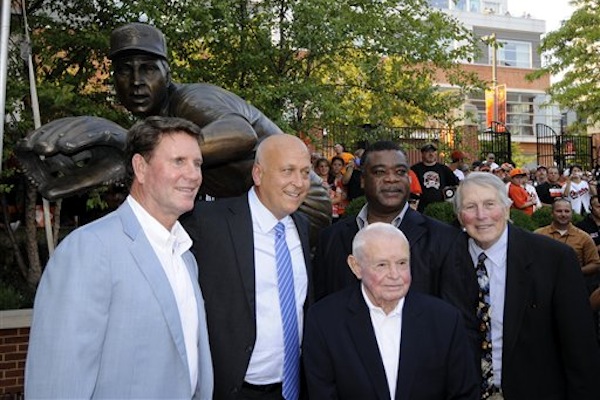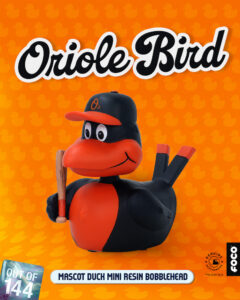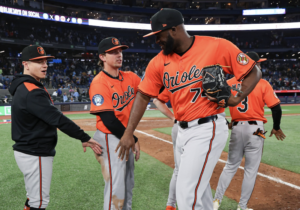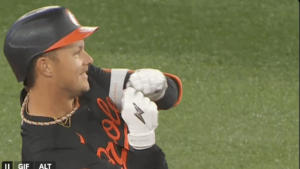With all the hubbub about Roberto Alomar’s selection to the Orioles Hall of Fame, many have forgotten to give the Orioles a little credit for what they unquestionably got right: last year’s statue honors for then all-living National Baseball Hall of Famers Frank Robinson, Brooks Robinson, Earl Weaver, Jim Palmer, Eddie Murray and Cal Ripken.
While all six were only able to come together at the same ceremony just a couple of times, the honors, though long overdue, were touching and fitting for the spectacular careers of these amazing Hall of Famers. As it turned out, the Orioles were able to honor the six in what turned out to be a magical season reminiscent of the many magical seasons led by the Hall of Famers, which in Palmer’s case included playing on all of the Orioles’ World Series-winning teams. And, of course, this was the last season the Orioles had to honor Earl Weaver while he was still alive. The Orioles are thus much-deserving of praise for what was done.
The problem is the Orioles only got it half-right: they did not honor ALL of their Hall of Fame players, just the ones living at the time. But by this omission, the Orioles missed a chance to recognize some of the greatest players and accomplishments in MLB history.
Proof of that can be found by taking a 15-minute drive from the statutory garden of Oriole Park at Camden Yards to an apartment building on E. 25th and Barclay Streets.
There’s no sign, no placard, no flag, no monument, nothing there but the walls of the apartment building that would tell you this was once where some of the greatest players in Major League history played baseball, who just happened to also be Baltimore Orioles Hall of Famers.
In 1891, this park opened to the public as the Orioles then joined the National League, upon the folding of the American Association. The Orioles played there till 1899 with great success until the National League contracted in 1900 and the Orioles were not one of the teams left standing.
In those days in what was called the “dead ball” era the Orioles were one of the greatest teams in baseball history, with stars SS Hughie Jennings, 3B John McGraw, C Wilbert Robinson, 1B Dan Brouthers, and OF Willie Keeler. All of these men are in the National Baseball Hall of Fame, as is their manager during those years, Ned Hanlon.
 The Orioles won three championships in those years, 1894-96, becoming known as one of the most successful teams in baseball history.
The Orioles won three championships in those years, 1894-96, becoming known as one of the most successful teams in baseball history.
Keeler, the subject of the still-used term “Baltimore Chop,” was famous for saying, “keep your eye on the ball and hit ‘em where they ain’t.” In Keeler’s case, that meant a lot of hits. After the 1898 season, Keeler’s career average was .385, which still remains the highest average in history for a player with 1,000 or more hits.
Keeler was also a master bunter. He would smack at the ball in an attempt to send it high into the sky. With his outstanding speed and quickness, Keeler could often beat out a throw to first by the time the opposing catcher or pitcher eventually got ahold of the sky-high “Baltimore Chop.”
In today’s game, perhaps only Yankees OF Ichiro Suzuki bears even a passing resemblance to players like Keeler. In the championship year of 1894, McGraw hit .340 and stole 78 bases, essentially a dead-ball era Rickey Henderson. McGraw later became the second-winningest manager in MLB history (behind Connie Mack of the Philadelphia Athletics).
Robinson hit .353 and drove in 98 runs in the ’94 season, amongst a great career. Jennings drove in 125 runs, hit .386 and stole 53 bases in the ’95 championship year. He would later become a successful manager with the Detroit Tigers. Brouthers only played one full season with the Orioles, the 1894 championship season, but hit .347 with 128 RBI and an astounding 23 triples.
Hanlon’s 1313 wins rank him 26th all-time, but he led the majors with seven consecutive seasons of .600-winning percentage baseball from 1894-1900.
Interestingly, the Tigers honored Jennings in 2000 in a ceremony recognizing many of their greats. McGraw has similarly been recognized by the San Francisco Giants organization (for managing them as the New York Giants) but the Orioles have not one banner flying that even mentions these great players.
It is true that after the league contracted in 1900, the Orioles eventually became a team known as the New York Highlanders, and later the New York Yankees, (a fact that, like Babe Ruth being from Baltimore also burns Yankee fans to this day. It is correct to say that today’s New York Yankees were once the Baltimore Orioles).
But the past should still be honored, the relatives of these great players should be found and given plaques and statues should be made in their honor. And the City of Baltimore should spend a couple dollars of its ever-increasing tax revenue and put a plaque on that ‘ole apartment building on Barclay.
So, while the Orioles feting their living stars last year was well-done and praise-worthy, the next step is to remember the past, the original past, as well.
SOURCES: Wikipedia, cross-references contained therein











11 Responses
I am currently working on a biography of Willie Keeler, so I appreciate your bringing the memory this great team to to your readers. Baltimore seems to have collective amnesia about the championship Orioles teams of the mid-1890s.
Lyle Spatz
Thank you for posting this story and for bringing this up. I also think players for the “minor” league teams should be honored, but the first step should honor those Orioles from the 1890s.
PS Let’s also honor the HOF players from the Elite Giants!
Agreed!
Well said Tom Moore, well said.
Nice article Tom. A good history lesson too. Unfortunately, I think most people forget that far back and only focus on the modern era.
Great history lesson and certainly good points. But I ask this — the current Orioles aren’t the same team as the 1890’s Orioles, so does it make sense to honor them as their own?
Maybe part of the Sports Legends Museum, sure. I think statues of these guys next to the likes of Weaver, Cakes, Brooksy, etc. would seem a bit out of place.
Keep the great comments coming. I think it is important to honor history. Hopefully the Orioles will make this a priority. Discussions like this are what might motivate them to do something. But yes, I think the accomplishments of the 1890’s Orioles are just as noteworthy as their 20th Century successors.
OK I know that “officially” the current Orioles are the same franchise as the St. Louis Browns and the Milwaukee Brewers (1901), but the Orioles were/are part of the fabric of this city and stretch back to those 1890s teams. I was raised to think of these Orioles as those Orioles–as part of that history of that team with that name in this city. My uncles, “white guys” all, also told me about going to see the Elite Giants. They are also part of Baltimore baseball. For goodness sake the Os wore the Elite Giants uniforms!! If that’s not an embrace of that heritage, what is? I’m not asking for statues, I’m just asking for a plaque with the names of those HOFers: Joe Black, Roy Campanella, Junior Gilliam, and Leon Day. While we’re at it, why not honor the Orioles’ International League teams? How about a plaque with the names of the five league MVPs from those teams?
Jim Johnson can’t save shit anymore. The Orioles suck and they are a fluke and proving all of the doubters riggt.I am ashamed to admit to being an Orioles Fan. You guys are a discrace to the uniform.
Thank god we have the Ravens because the O’s ONLY break hearts and just tease us. Damn bums….